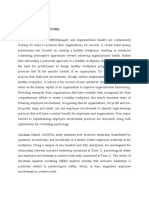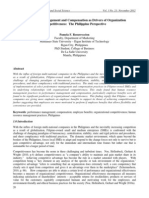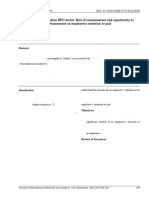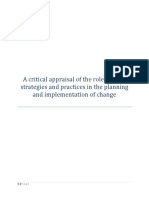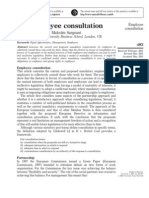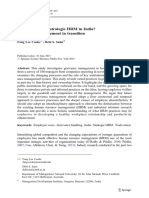Assignment 1
Assignment 1
Uploaded by
blueturtle1Copyright:
Available Formats
Assignment 1
Assignment 1
Uploaded by
blueturtle1Copyright
Available Formats
Share this document
Did you find this document useful?
Is this content inappropriate?
Copyright:
Available Formats
Assignment 1
Assignment 1
Uploaded by
blueturtle1Copyright:
Available Formats
A COMPARISON OF FORMS OF DIRECT EMPLOYEE INVOLVEMENT AND
COLLECTIVE REPRESENTATION IN TERMS OF WHAT VALUE THEY DELIVER TO THE EMPLOYEE.
HRM09104 Managing the Employment Relationship
Report by: To: Submission date: Word Count:
Charlotte Ates Monica McKinley (Lecturer) Wednesday 20 October 2010 1,096
Direct employee involvement and Collective Bargaining
Contents
Table of Contents
Introduction ................................................................................................................................ 3 General Background .................................................................................................................. 3 Employee Participation and Employee Involvement .................................................................. 4 Direct Employee Involvement Quality Circles ......................................................................... 6 Indirect Collective Representation Joint Negotiating and Consultative Committee ................. 6 Conclusion ................................................................................................................................. 7 References................................................................................................................................. 8 Appendices ................................................................................................................................ 9 Appendix 1 The Psychological Contract ............................................................................... 10 Appendix 2 Harvard model of HRM ...................................................................................... 11 Appendix 3 The 10 C model of HRM .................................................................................... 12 Appendix 4 Creating an engaged workforce (CIPD 2010) ................................................... 13
Page | 2
Direct employee involvement and Collective Bargaining
Introduction
This paper will present a comparison of one form of direct employee involvement (EI) to one form of indirect collective representation from the employee perspective. Following a general background to modern HRM it will define current understanding of employee participation (EP), EI and collective representation with reference to the underpinning theories. It will progress to a comparison of a direct form of EI (quality circles) and an indirect form of collective representation (Joint Negotiating and Consultative Committee, trade union based) in terms of the value these offer the employee.
General Background
The relationship between employer and employee has undergone a profound change in recent decades. The view has emerged that the management of people gives an organisation competitive advantage. This is driven by a number of factors the rise of consumerism, globalisation, market economies and the need to be more focussed on quality. Much of the development in employee relations arises from the concept or philosophy of the psychological contract (Schein 1965) (see Appendix 1) Modern theories of HR and HRM suggest that the goal of the organisation should be to achieve high levels of employee commitment and loyalty and that the most effective methods of achieving that goal is through EP and E!. The Harvard model (Beer et al 1984) (see Appendix 2) suggests that EI is pivotal to achieving engagement. The 10 C framework described in Human Resource Management in a Business Context (Price, 2003) (see Appendix 3) also places employee commitment as central aim of effective HRM. According to Creating an Engaged Workforce (CIPD, 2010) (see Appendix 4) Engagement is clearly associated with high levels of performance, reduced intent to quit and raised levels of personal well-beingemployees need to be given opportunities to express their views and to know that their opinions will be taken seriously.* The prevailing view is shown to be that to engage the commitment of employees, employers need to understand and fulfil expectations through processes that support EP and EI.
Page | 3
Direct employee involvement and Collective Bargaining
Employee Participation and Employee Involvement
According to the Chartered Institute of Personnel and Development EP is defined as a process of EI designed to provide employees with the opportunity to influence and take part in decision making on matters which affect them whereas, EI is designed to engage the support, understanding and optimum contribution of all employees and their commitment to its objectives. (CIPD, 2010) A clear distinction is made by Bratton & Gold who state that EP involves workers exerting a countervailing and upward pressure on management control, which need not imply unity of purpose between managers and non-managers. EI is perceived to be a softer form of participation, implying a commonality of interest between employees and management, and stressing that involvement should be directed at the workforce as a whole rather than being restricted to trade union channels. (Bratton & Gold, 2003) It is this definition which most closely matches my perspective of employment relations and one which informs the comparisons. It is therefore important to consider the imbalances of power to influence decision-making and how these can be addressed. Direct EI is where individual employees are involved in decision-making processes that affect their everyday routines. Examples include briefing groups, quality circles, and teams. In contrast, Indirect EI describes where representatives of employees participate in the decisionmaking process. Examples include Joint Consultative Committees, European Workers Councils and worker directors. (Leat 2007) Evaluation and analysis of forms of EI should examine the power dynamic of the employment relationship. A framework for analysis looks at depth, level, scope and form as shown in the diagram overleaf:
Page | 4
Direct employee involvement and Collective Bargaining
DEPTH degree of ability to influence decision-making
Work councils and worker directives Joint Negotiating and Consultation (Collective bargaining)
L e v e l in O r g a n is t io n Communication
Self-managed teams Cross-functional teams Consultation
Make decisions
Participation
Quality Circles Problem-solving groups
Financial Involvement
No decisionmaking
D IR E C T
F o rm s o f E I
IN D IR E C T
Figure 1 Dimensions of EI Bratton & Gold
Page | 5
Direct employee involvement and Collective Bargaining
Direct Employee Involvement Quality Circles
Arising from the Japanese model of HRM , quality circles have been a popular method of EI since the 1960s. The 2004 WERS survey found that 21% (rising from 16% in 1998) of workplaces had groups of non-managerial employees involved in problemsolving and quality improvement. (Kersley et al 2005) Typically, small groups of employees (typically between 5 15) meeting voluntarily to identify and solve operational problems, reduce defects and costs. They tend to operate in the lower echelons of an organisation. (Leat 2007) In terms of depth, quality circles have little authority and largely exist to provide recommendations on changes to working practices. Their scope is limited to a particular area of operations where they may implement changes that do not require management approval. (Leat 2007) Employees are encouraged to feel a sense of ownership and of sharing in management objectives. Employees gain an increased sense of satisfaction in their work as they have the power to improve productivity and quality. Participation in Quality Circles may also lead to recognition by management of an employees skills and abilities and may potentially improve an individuals promotion prospects. According to Herzbergs 2 factor theory of motivation these will lead to greater motivation and job satisfaction. (Hertzberg 1968)
Indirect Collective Representation Joint Negotiating and Consultative Committee
This describes where groups of employee representatives (union or non union) meet with a senior management team. Collective bargaining is a means of reconciling conflicting interests between employee and employer and focuses largely on the formal contract of employment, that is, pay and working conditions. Discussions take place at top levels of an organisation and can involve sharing and exchanges of information on organisational matters and may include consultation on employment policies. These provide the opportunity for the employee voice to be articulated upwardly to an extent but are often perceived by employees as being ineffective. It can be said that both trade union and managements attitudes towards each other form obstacles to facilitating EI due to the divergence of interest and imbalance of power. Employees perception of union participation on their behalf in the introduction of flexibility is that it has led to work intensification and a rise in temporary contract workers. (Leat 2007)
Page | 6
Direct employee involvement and Collective Bargaining
Conclusion
Employee engagement is a legitimate objective for management but the evidence shows that both the direct and indirect forms of EI described have limited success in achieving this. Quality circles have limited scope and depth and generate little sense of involvement or satisfaction. Collective bargaining, though set in a more robust framework is similarly constrained in its ability to influence decision-making. Neither address the imbalance of power between management and employee.
Page | 7
Direct employee involvement and Collective Bargaining
References
Beer, M., Spector, B., Lawrence, PR, Quinn Mills, D and Walton, R, 1984. Managing Human Assets, Free Press, New York Price A, Human Resource Management in a Business Context (2nd edition) Thomson Learning; (10 Oct 2003) Bratton, J and Gold, J, Human Resource Management: Theory and Practice 3rd edition 2003 Palgrave McMillan CIPD Research Report: Creating an engaged workforce, findings from the Kingston Employee Engagement Consortium. January 2010 available from http://www.cipd.co.uk/subjects/empreltns/general/_creating_engaged_workforce.htm accessed on 10 October 2010 CIPD Employee engagement (revised July 2010) available from http://www.cipd.co.uk/subjects/empreltns/general/empengmt.htm?IsSrchRes=1 accessed on 10 October 2010 Herzberg, F "The Motivation-Hygiene Concept and Problems of Manpower", Personnel Administration (January-February 1964), pp. 37. Kersley, B Alpin, C, Forth, J, Bryson, A, Bewley, H, Dix, G and Oxenbridge, S 2005 Inside the Workplace First Findings from the 2004 Workplace Employment Survey (WERS 2004) Leat, M, Exploring Employee Relations, (2nd Edition) Elsevier Ltd, Oxford 2007 Schein, E.H. Organizational Psychology (3rd Edition) Prentice Hall: Englewood Cliffs, NJ, 1988. Seijts, G.H. and Crim, D. What engages employees the most or: the ten Cs of employee engagement. Ivey Business Journal. Vol 70, No 4. pp15. (2006)
Page | 8
Direct employee involvement and Collective Bargaining
Appendices
Page | 9
Direct employee involvement and Collective Bargaining
Appendix 1 The Psychological Contract
Schein described this contract as a set of unwritten set of expectations operating between employees and employers. Seen from the employees perspective this means the obligations, rights and rewards he/she is owed by their employer in return for their work and loyalty.
Figure 2 Psychological contract - iceberg model (Schein 1965)
The iceberg model illustrates how much is involved in the psychological contract that is not explicitly described in the formal employment contract.
Page | 10
Direct employee involvement and Collective Bargaining
Appendix 2 Harvard model of HRM
Figure 3 Harvard Model of HRM
The Harvard Model places employee involvement as central to the HRM system.
Page | 11
Direct employee involvement and Collective Bargaining
Appendix 3 The 10 C model of HRM
Figure 4 10 C model of HRM (Price 2005)
The 10 C model shows that to achieve employee commitment and meet the challenge of change that HRM must drive a comprehensive and coherent strategy with regards to management of people.
Page | 12
Direct employee involvement and Collective Bargaining
Appendix 4 Creating an engaged workforce (CIPD 2010)
Meaningfulness of work Person to job fit Supportive work environment
Engagement
Voice, being able to feed voice upwards Management, communication and vision
Line management
Figure 5 Creating an Engaged Workforce CIPD
Page | 13
You might also like
- Employement Relation: 1. BackgroundDocument14 pagesEmployement Relation: 1. Backgroundarshedhamed100% (3)
- HRP 013n New Form Managing Seminar - Main - 2010 July 27Document20 pagesHRP 013n New Form Managing Seminar - Main - 2010 July 27LakusabaNo ratings yet
- 15Mbap025-Pradeep Kumar.C Industrial Relation (Ir) Exploring Employee Participation and Work Environment in Food Processing Industry: Case Studies From Denmark and New ZealandDocument12 pages15Mbap025-Pradeep Kumar.C Industrial Relation (Ir) Exploring Employee Participation and Work Environment in Food Processing Industry: Case Studies From Denmark and New ZealandPradeep ChandrasekarNo ratings yet
- WilkinsonDocument18 pagesWilkinsonAkshay DagurNo ratings yet
- Chapter 10 - Employment RelationsDocument32 pagesChapter 10 - Employment RelationsZav DhillonNo ratings yet
- Towards HRM? A Case Study From Banking: Adrian WilkinsonDocument21 pagesTowards HRM? A Case Study From Banking: Adrian WilkinsonRehman KhanNo ratings yet
- Employee EngagementDocument82 pagesEmployee EngagementKolade FolamiNo ratings yet
- A Definition of Employee RetentionDocument13 pagesA Definition of Employee RetentionDev SharmaNo ratings yet
- Research Paper On Employee EngagementDocument9 pagesResearch Paper On Employee EngagementRutwickNo ratings yet
- Marchington-2015-Human Resource Management JournalDocument18 pagesMarchington-2015-Human Resource Management JournalChristian Paulo BelisarioNo ratings yet
- On The Role of Human Resource Intermediaries - Basic Concepts and Research PDFDocument2 pagesOn The Role of Human Resource Intermediaries - Basic Concepts and Research PDFFredrik MarkgrenNo ratings yet
- "Employee Engagement at Tata Steel": Rohini, Rajesh Kumar Upadhyay, DeepshikhaDocument11 pages"Employee Engagement at Tata Steel": Rohini, Rajesh Kumar Upadhyay, Deepshikhasomachoudhary093No ratings yet
- Workers Participation in ManagementDocument33 pagesWorkers Participation in Managementk eswari100% (3)
- HRM - A Contributor To Employee AlienationDocument21 pagesHRM - A Contributor To Employee AlienationRaja PunianiNo ratings yet
- Study On Employer and Employee Relationship Review of The LiteratureDocument7 pagesStudy On Employer and Employee Relationship Review of The LiteraturelooserNo ratings yet
- Employee Voice 111Document10 pagesEmployee Voice 111Ahmed YusufNo ratings yet
- Research CompensationDocument32 pagesResearch Compensationvirajpatel.inNo ratings yet
- EJMCM - Volume 8 - Issue 1 - Pages 1200-1212Document13 pagesEJMCM - Volume 8 - Issue 1 - Pages 1200-1212Morrison Omokiniovo Jessa Snr100% (1)
- Independent University, BangladeshDocument5 pagesIndependent University, BangladeshMostafa ZubaerNo ratings yet
- 5IVPDocument10 pages5IVPGlendale De Zilva100% (1)
- Restricted: REF: JCSC/CRP/15/17 No of Words: 5078Document13 pagesRestricted: REF: JCSC/CRP/15/17 No of Words: 5078mbatiNo ratings yet
- HRM A Contributor To Employee AlienationDocument10 pagesHRM A Contributor To Employee AlienationJerome BasivuNo ratings yet
- Review of Literature:: (Matthew J. Grawitch, 2009)Document6 pagesReview of Literature:: (Matthew J. Grawitch, 2009)Sylve SterNo ratings yet
- Employment Relations and Employee Engagement in DR - Reddy'S LabDocument10 pagesEmployment Relations and Employee Engagement in DR - Reddy'S LabChaitanya DachepallyNo ratings yet
- Towards HRM? A Case Study From Banking: Adrian WilkinsonDocument18 pagesTowards HRM? A Case Study From Banking: Adrian Wilkinsonrohith06No ratings yet
- Employee EngagemenEMPLOYEE ENGAGEMENT: CONCEPTUAL ISSUEStDocument11 pagesEmployee EngagemenEMPLOYEE ENGAGEMENT: CONCEPTUAL ISSUEStDinesh RoyalNo ratings yet
- Factors Affecting Employee Turnover TheDocument11 pagesFactors Affecting Employee Turnover TheAminullah HassamNo ratings yet
- Research Proposal / Synopsis: Managing Employee Retention Through Employees Engagement in An OrganizationDocument11 pagesResearch Proposal / Synopsis: Managing Employee Retention Through Employees Engagement in An OrganizationElegant EmeraldNo ratings yet
- MGT2019 Individual AssignmentDocument11 pagesMGT2019 Individual AssignmentPrunella YapNo ratings yet
- Employee RetentionDocument14 pagesEmployee RetentionRonnie GaoNo ratings yet
- WPM in PDFDocument6 pagesWPM in PDFpratiksha bhattaraiNo ratings yet
- Importance of Employee Relations For An OrganizationDocument7 pagesImportance of Employee Relations For An Organizationpriyanka senanayake50% (2)
- Jurnal Kompensasi PDFDocument11 pagesJurnal Kompensasi PDFMuhammad KasranNo ratings yet
- Employee Relations Research Paper Group 4 (Review) (1) - CG CommentsDocument10 pagesEmployee Relations Research Paper Group 4 (Review) (1) - CG Commentsmv79No ratings yet
- Jmra 5 3 239 243Document5 pagesJmra 5 3 239 243ezekielvencioNo ratings yet
- Case Study HRMDocument18 pagesCase Study HRMKhushbu Shah100% (2)
- A Critical Appraisal of The Role of HRM Strategies and Practices in The Planning and Implementation of ChangeDocument14 pagesA Critical Appraisal of The Role of HRM Strategies and Practices in The Planning and Implementation of ChangeFaria Hashim AliNo ratings yet
- Strategic Human Resources AssignmentDocument10 pagesStrategic Human Resources Assignmentabanoub khalaf 22No ratings yet
- 2018 4 2 5 DyczkowskaDocument26 pages2018 4 2 5 Dyczkowskabakhtawar soniaNo ratings yet
- Esther Project - 1-3Document10 pagesEsther Project - 1-3sundayNo ratings yet
- Sargeant ER01Document15 pagesSargeant ER01api-3717481No ratings yet
- 2011 SubramonyMWeb11 - 1Document14 pages2011 SubramonyMWeb11 - 1KammyKalam IpNo ratings yet
- Caroline Fernandes - New Order 1x Psychology and Employee EngagementDocument13 pagesCaroline Fernandes - New Order 1x Psychology and Employee EngagementPritom ShimantaNo ratings yet
- Assignment For Employee RelationsDocument7 pagesAssignment For Employee RelationsjeevanNo ratings yet
- Pay Performance Participation No 92 28Document47 pagesPay Performance Participation No 92 28Mohammad QawasmiNo ratings yet
- Employee Turnover Influence Factor and CountermeasureDocument19 pagesEmployee Turnover Influence Factor and CountermeasureJavierNo ratings yet
- Retail Industry in BangkokDocument16 pagesRetail Industry in BangkokNanang RiyadiNo ratings yet
- Chapter 2 (41-94)Document54 pagesChapter 2 (41-94)eswariNo ratings yet
- Ajeba1239 44Document6 pagesAjeba1239 44Shahbaz AftabNo ratings yet
- Amit ChowdhuryDocument15 pagesAmit ChowdhuryAmit ChowdhuryNo ratings yet
- Employee GreivanceDocument26 pagesEmployee GreivanceMarutiNo ratings yet
- Assignment ManagmentDocument4 pagesAssignment ManagmentSobia AshrafNo ratings yet
- Managing Labor RelationsDocument4 pagesManaging Labor RelationsMarc Lorenz CabreraNo ratings yet
- Employee Relation Rol 1Document13 pagesEmployee Relation Rol 1lavina100% (1)
- Human Resource Management and Employee Well-Being: Towards A New Analytic FrameworkDocument17 pagesHuman Resource Management and Employee Well-Being: Towards A New Analytic FrameworkDiego Flores LopezNo ratings yet
- Literature Review For Employee EngagementDocument7 pagesLiterature Review For Employee EngagementSatish J. MakwanaNo ratings yet
- T. S. Eliot, "Modern Tendencies in Poetry"Document15 pagesT. S. Eliot, "Modern Tendencies in Poetry"Thomas PfauNo ratings yet
- An Introduction To Buyer Behaviour: Nishan NavaratneDocument24 pagesAn Introduction To Buyer Behaviour: Nishan NavaratneArjuna PalihapitiyaNo ratings yet
- Electroacoustic Performance Practice in Interdisciplinary Improvisation James AndeanDocument10 pagesElectroacoustic Performance Practice in Interdisciplinary Improvisation James AndeanMarcelo CarneiroNo ratings yet
- ENG 3CMaus Chapter Five - The Second HoneymoonDocument4 pagesENG 3CMaus Chapter Five - The Second Honeymoonharry nguyenNo ratings yet
- Hegel's Absolute IdealismDocument3 pagesHegel's Absolute Idealismmichael jhon amisolaNo ratings yet
- Gombrowicz's Grimaces and GamesDocument6 pagesGombrowicz's Grimaces and GamesFernando UribeNo ratings yet
- Realization, Composition, Inheritance GeneralizationDocument6 pagesRealization, Composition, Inheritance GeneralizationRajeswari MahalingamNo ratings yet
- A Guide To The Kalachakra EmpowermentDocument34 pagesA Guide To The Kalachakra EmpowermentWill Ostoj100% (4)
- PMP Prep Exam Part 3Document5 pagesPMP Prep Exam Part 3tippurajNo ratings yet
- Adriana KouliasThe Holy GrailDocument27 pagesAdriana KouliasThe Holy GrailGypsysky80% (5)
- UntitleddocumentDocument7 pagesUntitleddocumentapi-285179656No ratings yet
- The Ten LakshanasDocument2 pagesThe Ten LakshanasRADHAKRISHNAN100% (2)
- Women S Tantric Massage ExperienceDocument12 pagesWomen S Tantric Massage Experiencesicomo33% (3)
- On Peace As The Final Cause of The UniverseDocument12 pagesOn Peace As The Final Cause of The UniverseSancrucensisNo ratings yet
- Health Lesson ThreeDocument5 pagesHealth Lesson Threeapi-283239473No ratings yet
- 3.044 Materials Processing: ρ c T ρ c kDocument8 pages3.044 Materials Processing: ρ c T ρ c kAlejandroNo ratings yet
- Brand Adoption PracticesDocument16 pagesBrand Adoption PracticesThulasi Brindha50% (2)
- Wayseers ManifestoDocument2 pagesWayseers ManifestoKovács PéterNo ratings yet
- Thompson2012 Lynn Contrib To IQDocument5 pagesThompson2012 Lynn Contrib To IQDavidNo ratings yet
- Critical Analysis of Balanced ScorecardDocument24 pagesCritical Analysis of Balanced ScorecardDaegal LeungNo ratings yet
- Basic Quality ConceptDocument5 pagesBasic Quality ConceptZulizudinOthmanNo ratings yet
- GEAS Oct2013 Ref 3 With Answers PDFDocument6 pagesGEAS Oct2013 Ref 3 With Answers PDFcajaroNo ratings yet
- Judaism and Christianity: A ComparaisonDocument2 pagesJudaism and Christianity: A ComparaisonnNo ratings yet
- 250 List of Things That Are Forbidden in General Terms Forbidden in The Noble QuranDocument2 pages250 List of Things That Are Forbidden in General Terms Forbidden in The Noble QuranitsokokNo ratings yet
- Publikationensliste Matzler 2014novDocument24 pagesPublikationensliste Matzler 2014novMuchtar ZarkasyiNo ratings yet
- Analysis Concept and PrincipleDocument21 pagesAnalysis Concept and PrincipleAdi SetiadiNo ratings yet
- FINOCCHIARO Retrying Galileo, 1633-1992 (KW Science Astronomy) PDFDocument498 pagesFINOCCHIARO Retrying Galileo, 1633-1992 (KW Science Astronomy) PDFRodrigo Braicovich100% (1)
- Douglas M. Kellner - Critical Theory, Marxism and Modernity-Polity Press (1989)Document284 pagesDouglas M. Kellner - Critical Theory, Marxism and Modernity-Polity Press (1989)Jovana VukosavljevićNo ratings yet
- Essay PlanDocument3 pagesEssay Plandancer_upstairs2000No ratings yet
- Legal & Ethical: 1.1 Differences Between Laws and EthicsDocument1 pageLegal & Ethical: 1.1 Differences Between Laws and EthicsElit HakimiNo ratings yet






















